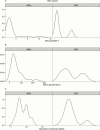Nerve growth factor and neuropeptides circulating levels in systemic sclerosis (scleroderma)
- PMID: 11302871
- PMCID: PMC1753627
- DOI: 10.1136/ard.60.5.487
Nerve growth factor and neuropeptides circulating levels in systemic sclerosis (scleroderma)
Abstract
Objective: To determine the circulating levels of nerve growth factor (NGF), neuropeptide Y (NPY), and vasoactive intestinal peptide (VIP) in systemic sclerosis (SSc), and to correlate these levels with clinical and laboratory features.
Methods: Forty four patients with SSc were evaluated for circulating NGF (immunoenzymatic assay), NPY and VIP (radioimmunoassay), anticentromere and antitopoisomerase I autoantibodies, lung disease (pulmonary function tests with carbon monoxide transfer factor (TLCO), ventilation scintiscan with 99mTc DTPA radioaerosol, high resolution computed tomography (HRCT), pulmonary pressure (echo colour Doppler)), heart disease (standard and 24 ECG, echocardiography), cutaneous involvement (skin score), joint involvement (evidence of tender or swollen joints, or both), peripheral nervous system (PNS) involvement (electromyography), rheumatoid factor, angiotensin converting enzyme (fluorimetric method), von Willebrand factor (ELISA), and erythrocyte sedimentation rate (ESR) (Westergren).
Results: Circulating NGF levels in SSc were significantly increased compared with controls (p<0.00001) and significantly higher in the diffuse than in the limited subset of patients (p<0.01). Patients with articular disease had significantly higher levels of NGF. A significant indirect correlation between NGF levels and TLCO was detected (p<0.01), but no correlation was found between NGF and HRCT, DTPA, skin score, PNS involvement and angiotensin converting enzyme and von Willebrand factor levels, antitopoisomerase or anticentromere antibodies, and ESR. NGF levels increased progressively as the disease worsened. Similarly, VIP circulating levels were significantly increased in patients with SSc (p<0.001), whereas the increase of NPY levels did not reach statistical significance. However, both neuropeptides, following the same trend as NGF, increased as the disease worsened (skin score and lung disease).
Conclusions: The increase of NGF and VIP in patients with SSc, the former in the diffuse subset of the disease, and in patients with prominent articular disease, may suggest a link between neurotransmitters and the disease pathogenesis. Neuropeptide circulating levels seem to increase only in patients with the most severe disease.
Figures





Similar articles
-
Anti-endothelial cell antibodies in systemic sclerosis: significant association with vascular involvement and alveolo-capillary impairment.Clin Exp Rheumatol. 1998 Sep-Oct;16(5):527-32. Clin Exp Rheumatol. 1998. PMID: 9779298
-
Effects of loratadine and cetirizine on serum levels of neuropeptides in patients with chronic urticaria.Int J Dermatol. 2014 Dec;53(12):1526-30. doi: 10.1111/ijd.12590. Epub 2014 Sep 10. Int J Dermatol. 2014. PMID: 25209952
-
The clinical significance of serum N-terminal pro-brain natriuretic peptide in systemic sclerosis patients.Clin Rheumatol. 2008 Apr;27(4):437-42. doi: 10.1007/s10067-007-0724-9. Epub 2007 Sep 25. Clin Rheumatol. 2008. PMID: 17899307
-
Serum concentration of surfactant protein D in patients with systemic sclerosis: The potential marker of the interstitial lung disease severity.Best Pract Res Clin Rheumatol. 2018 Aug;32(4):541-549. doi: 10.1016/j.berh.2019.01.005. Epub 2019 Feb 14. Best Pract Res Clin Rheumatol. 2018. PMID: 31174823 Review.
-
Rituximab in the treatment of patients with systemic sclerosis. Our experience and review of the literature.Autoimmun Rev. 2015 Nov;14(11):1072-8. doi: 10.1016/j.autrev.2015.07.008. Epub 2015 Jul 22. Autoimmun Rev. 2015. PMID: 26209905 Review.
Cited by
-
An underlying mechanism behind interventional pulmonology techniques for refractory asthma treatment: Neuro-immunity crosstalk.Heliyon. 2023 Oct 10;9(10):e20797. doi: 10.1016/j.heliyon.2023.e20797. eCollection 2023 Oct. Heliyon. 2023. PMID: 37867902 Free PMC article. Review.
-
Gastric slow waves, gastrointestinal symptoms and peptides in systemic sclerosis patients.Neurogastroenterol Motil. 2009 Dec;21(12):1269-e120. doi: 10.1111/j.1365-2982.2009.01350.x. Epub 2009 Jun 30. Neurogastroenterol Motil. 2009. PMID: 19566588 Free PMC article.
-
Low density of sympathetic nerve fibres and increased density of brain derived neurotrophic factor positive cells in RA synovium.Ann Rheum Dis. 2005 Jan;64(1):13-20. doi: 10.1136/ard.2003.016154. Ann Rheum Dis. 2005. PMID: 15608299 Free PMC article.
-
Nerve growth factor, neuropeptides and cutaneous nerves in atopic dermatitis.Indian J Dermatol. 2010 Apr-Jun;55(2):135-9. doi: 10.4103/0019-5154.62735. Indian J Dermatol. 2010. PMID: 20606880 Free PMC article.
-
Evidence for targeting autonomic dysfunction in systemic sclerosis: A scoping review.J Scleroderma Relat Disord. 2025 Jan 8:23971983241308050. doi: 10.1177/23971983241308050. Online ahead of print. J Scleroderma Relat Disord. 2025. PMID: 39790996 Free PMC article. Review.
References
MeSH terms
Substances
LinkOut - more resources
Full Text Sources
Medical
Miscellaneous

